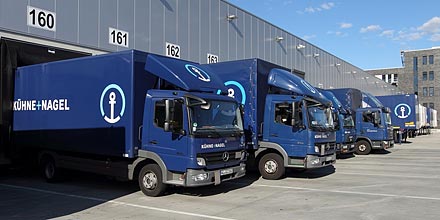 Last month the Swiss air freight company Kuehne + Nagel International AG was fined just over NZ$3m (around £1.5m) by the New Zealand Commerce Commission for their part in a price fixing cartel that ran for 5 years.
Last month the Swiss air freight company Kuehne + Nagel International AG was fined just over NZ$3m (around £1.5m) by the New Zealand Commerce Commission for their part in a price fixing cartel that ran for 5 years.
In 2002 the firms in the industry faced higher costs due to increased security measures imposed by the British government. They formed a cartel to agree to pass these increased costs on to their customers for air freight services from the UK to a number of countries, including New Zealand. The investigation by the New Zealand competition authority followed a leniency application by one of the participants in 2007. Five other participants had previously been fined, but Kuehne + Nagel decided to fight the case. The fine imposed on them brought the total fines to almost NZ$12m (around £6m).
 A previous post on this site highlighted how golf played a prominent role in several previous cartels. However, this cartel seemed to have had a fixation on gardening and referred to the cartel as the gardening club. Other parties involved in the cartel were referred to as fellow gardeners and the agreed upon price as the price for asparagus! When a participant suspected a rival may have cheated on the cartel agreement email exchanges such as this one took place:
A previous post on this site highlighted how golf played a prominent role in several previous cartels. However, this cartel seemed to have had a fixation on gardening and referred to the cartel as the gardening club. Other parties involved in the cartel were referred to as fellow gardeners and the agreed upon price as the price for asparagus! When a participant suspected a rival may have cheated on the cartel agreement email exchanges such as this one took place:
I hear… concerns about the price of produce from the garden of Velcro, which appears to be operating as a charitable cooperative for the benevolence of vegetable eaters rather than growers…
It is not known whether the Kuehne + Nagel employees involved in the cartel were placed on gardening leave during the investigation!
‘Gardening Club’ hid hardcore air freight cartel New Zealand Herald, Hamish Fletcher (04/04/14)
‘Gardening Club’ Air Freight Forwarding Cartel Finally Buried by High Court Handy Shipping Guide (08/04/14)
Swiss firm fined $3.1 million over cartel 3 News (08/04/14)
‘Gardening Club’ freight cartel participant, Kuehne + Nagel, fined $3.1m The National Business Review (08/04/14)
Questions
- Why is an increase in costs likely to trigger price fixing behaviour?
- Why might the members want to use code names to run a cartel’s activities?
- Why do competition authorities grant leniency to cartel members that inform them about price fixing behaviour?
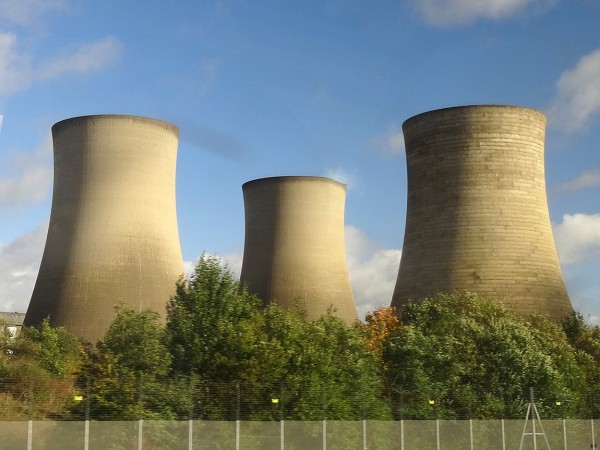
As Elizabeth noted in Fuelling the Political Playing Field, there has been much debate recently about energy prices in the UK. Four of the ‘Big Six’ energy companies have now announced price rises. They average 9.1% – way above the rate of consumer price inflation and even further above the average rate of wage increases. What is more, they are considerably above the rate of increase in wholesale energy prices, which, according to Ofgem, have risen by just 1.7% in the past year.
The bosses of the energy companies have appeared before the House of Commons Energy and Climate Change Select Committee to answer for their large price increases. The energy companies claim that the increases are necessary to cover not only rising wholesale prices, but also green levies by the government and ‘network charges’ for investments in infrastructure. 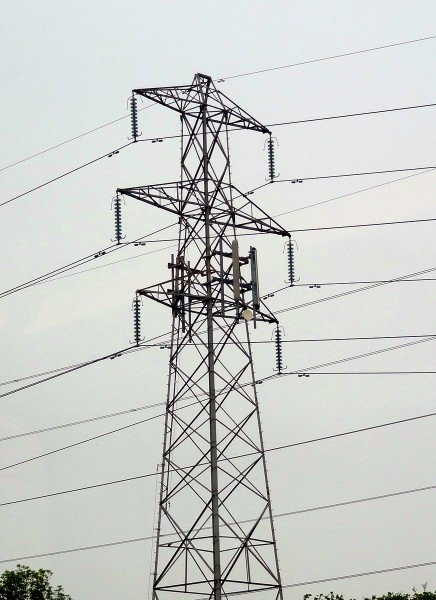 However, it is hard to see how, even taking into account all three of these possible sources of cost increases, the scale of price increases can be justified.
However, it is hard to see how, even taking into account all three of these possible sources of cost increases, the scale of price increases can be justified.
Another possible explanation for the price hikes is that they are partly the result of a system of transfer pricing (see). The energy industry is vertically integrated. Energy companies are not only retailers to customers, but also generators of electricity and wholesale shippers of gas. It is possible that, by the producing/shipping arms of these companies charging higher prices to their retailing arms, the retailers’ costs do indeed go up more than the wholesale market cost. The result, however, is higher profits for the producing arms of these businesses. In other words, a higher transfer price allows profits to be diverted from each company’s retailing arm to its producing arm.
 This is an argument for making the wholesale market more competitive and for stopping the by-passing of this market by producing arms of companies selling directly to their retailing arms. What the companies are being accused of is an abuse of market power and possibly of colluding with each other, at least tacitly, to support the continuation of such a practice.
This is an argument for making the wholesale market more competitive and for stopping the by-passing of this market by producing arms of companies selling directly to their retailing arms. What the companies are being accused of is an abuse of market power and possibly of colluding with each other, at least tacitly, to support the continuation of such a practice.
So is the answer a price freeze, as proposed by the Labour Party? Is it an investigation of the energy market by the Competition Commission? Or is it, at least as a first step, much more openness by the energy companies and transparency about their pricing practices? Or is it to encourage consumers to switch between energy companies, including the smaller ones, which at present account for less than 5% of energy supply? The videos, podcasts and articles consider these issues.
Webcasts and Podcasts
 Energy bosses blame high bills on wholesale prices Channel 4 News, Gary Gibbon (29/10/13)
Energy bosses blame high bills on wholesale prices Channel 4 News, Gary Gibbon (29/10/13)
 Why are energy bosses being questioned? BBC News, Stephanie McGovern (29/10/13)
Why are energy bosses being questioned? BBC News, Stephanie McGovern (29/10/13)
 Key questions Big Six energy companies must answer The Telegraph, Ann Robinson (29/10/13)
Key questions Big Six energy companies must answer The Telegraph, Ann Robinson (29/10/13)
 Energy bosses offer excuses for prices rises The Telegraph (29/10/13)
Energy bosses offer excuses for prices rises The Telegraph (29/10/13)
 Energy bosses face MPs over price rises BBC News, John Moylan (29/10/13)
Energy bosses face MPs over price rises BBC News, John Moylan (29/10/13)
 Energy boss ‘can’t explain’ competitors’ price hikes The Telegraph (29/10/13)
Energy boss ‘can’t explain’ competitors’ price hikes The Telegraph (29/10/13)
 Ovo boss: Competition Commission would take too long BBC News (30/10/13)
Ovo boss: Competition Commission would take too long BBC News (30/10/13)
 Dale Vince: Energy market is ‘dysfunctional’ BBC Today Programme (30/10/13)
Dale Vince: Energy market is ‘dysfunctional’ BBC Today Programme (30/10/13)
 Tony Cocker: Public mistrust energy industry BBC Today Programme (30/10/13)
Tony Cocker: Public mistrust energy industry BBC Today Programme (30/10/13)
 Ed Davey: Energy deals not just for ‘internet savvy’ BBC Today Programme (31/10/13)
Ed Davey: Energy deals not just for ‘internet savvy’ BBC Today Programme (31/10/13)
Articles
Energy giants ‘charge as much as they can get away with’ The Telegraph, Peter Dominiczak (29/10/13)
UK energy markets need perestroika Financial Times (27/10/13)
Britain’s energy utilities must embrace glasnost Reuters, John Kemp (29/10/13)
Small energy firms ‘escape levies’ BBC News (30/10/13)
Is the energy market structurally flawed? BBC news, Robert Peston (30/10/13)
The energy market needs a Competition Commission investigation Fingleton Associates, John Fingleton (12/10/13)
Energy firms raised prices despite drop in wholesale costs The Guardian, Rowena Mason (29/10/13)
Only full-scale reform of our energy market will prevent endless price rises The Observer, Phillip Lee (26/10/13)
Energy Giants Blame Rising Bills On Green ‘Stealth Taxes’ Huffington Post, Asa Bennett (29/10/13)
Big Six energy firms ‘like cartel’ Belfast Telegraph (30/10/13)
Energy boss says he hasn’t done sums on green levies The Telegraph, Georgia Graham (30/10/13)
Graphic: How your energy bills have soared in ten years The Telegraph, Matthew Holehouse (30/10/13)
British energy suppliers’ explanations for price hikes just don’t add up The Guardian, Larry Elliott (31/10/13)
The 18th energy market investigation since 2001: Will this one be different? The Carbon Brief, Ros Donald (31/10/13)
Energy: Is there enough competition in the market? BBC News, Hugh Pym (26/11/13)
Information and Reports
Wholesale [electricity] market Ofgem
Wholesale [gas] market Ofgem
Response on wholesale energy costs Ofgem Press Release (29/10/13)
Response to Government’s Annual Energy Statement Ofgem Press Release (31/10/13)
Real Energy Market Reform The Labour Party
Questions
- Why may the costs of energy paid by the energy retailers to energy producers/shippers have risen more than the wholesale price?
- Explain what is meant by transfer pricing. How could transfer pricing be used to divert profits between the different divisions of a business?
- How can transfer pricing be designed by multinational companies to help them minimise their tax bills?
- Why is policing transfer pricing arrangements notoriously difficult?
- What evidence is there to show that switching between retailers by customers can help to drive retail energy prices down?
- How did the old electricity pool system differ from the current wholesale system?
- Should electricity companies be forced to pool the electricity they generate and not sell it to themselves through bilateral deals?
- Comment on the following: “The current electricity trading arrangements ‘create the very special incentive for the oligopolists. …The best of all possible worlds is where nobody invests. As supply and demand close up, the price spikes upwards, and supernormal profits result.'”
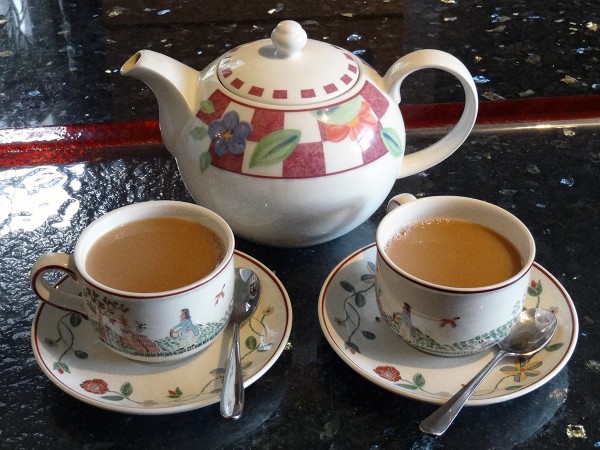 Six of the major tea producing countries – India, Kenya, Sri Lanka, Indonesia, Rwanda and Malawi – have formed an International Tea Producers’ Forum (ITPF). Together these countries produce slightly more than the world’s tea. The hope of the members of the new ITPF is that their cartel will allow them to increase the price of tea to the growers and to create greater price stability.
Six of the major tea producing countries – India, Kenya, Sri Lanka, Indonesia, Rwanda and Malawi – have formed an International Tea Producers’ Forum (ITPF). Together these countries produce slightly more than the world’s tea. The hope of the members of the new ITPF is that their cartel will allow them to increase the price of tea to the growers and to create greater price stability.
According to the Assam Tribune article below:
ITPF’s main objectives include – safeguarding the interests of the tea-producing countries, evolving collective solutions for the problems facing the producers, providing technical cooperation, sharing of technology and expertise by the member countries, undertaking market studies and research projects to address any specific issues concerning tea in general or any variety of tea, among others.
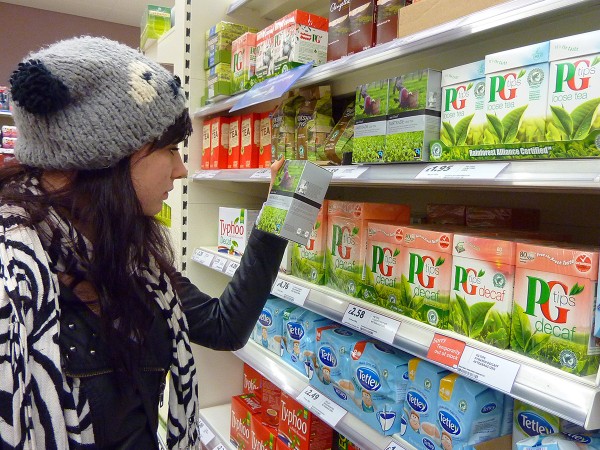 And according to the article from Sri Lanka’s Daily News:
And according to the article from Sri Lanka’s Daily News:
Chairman of the Planters’ Association of Ceylon, which represents the interests of 23 Regional Plantation Companies, Lalith Obeyesekere said this was a landmark occasion. Sri Lanka particularly looks to the forum to provide long-term sustainability to the tea industry in maintaining price stability and quality standards, among the other objectives set out in the mandate… The Planters’ Association said they were confident that Sri Lanka could use the ITPF to re-look at the industry in order that local tea producers realize their full potential.
Sri Lanka’s plantation industries minister Mahinda Samarasinghe said:
The bulk of production is in the hands of smallholders. So there’s a need to increase their incomes. Price stability is definitely important.
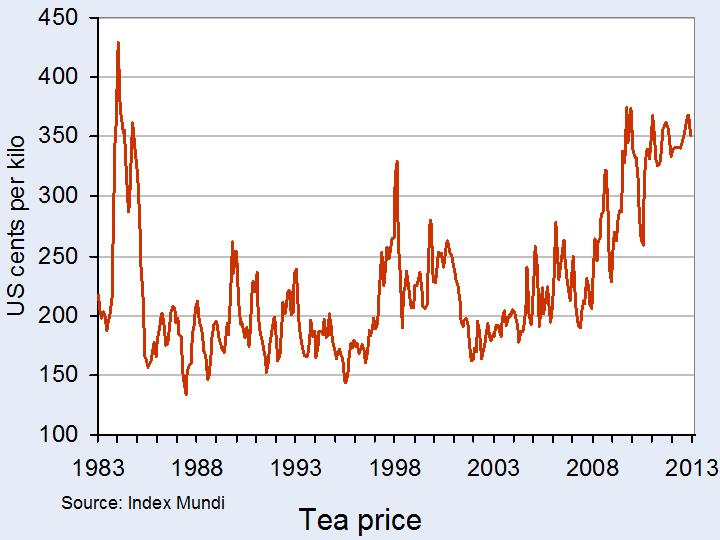 The main aim of the ITPF over the longer term is likely to be to raise tea prices. The chart shows international tea prices from 1983 to the present day. As you can see, they have fluctuated considerably. Note that these are prices in nominal terms and hence do not take inflation into account. Click here for a PowerPoint of the chart.
The main aim of the ITPF over the longer term is likely to be to raise tea prices. The chart shows international tea prices from 1983 to the present day. As you can see, they have fluctuated considerably. Note that these are prices in nominal terms and hence do not take inflation into account. Click here for a PowerPoint of the chart.
But if the main aim is to increase prices to tea growers, how could this be achieved? One objective of the ITPF is to stimulate demand for tea by ‘promoting tea consumption through generic promotional campaigns’. The aim would be to encourage people to switch from coffee and soft drinks.
 But to take advantage of its market power, the cartel might also want to reduce tea production, thereby pushing up the price. This, of course, would be more feasible if it had a larger than 50% share of the market.
But to take advantage of its market power, the cartel might also want to reduce tea production, thereby pushing up the price. This, of course, would be more feasible if it had a larger than 50% share of the market.
Although production quotas are not currently part of the agreement, these are likely to be considered at future meetings, especially if the three other large producers – China, Vietnam and Iran – can be persuaded to join.
China, with some 38% of the market, is the world’s largest tea producer. Although it sent an observer to the meeting (as did Iran), it was not one of the signatories. If it could be persuaded to join the cartel, this would increase its power. Nevertheless, China specialises in different types of tea, mainly green teas, and is not the world’s biggest exporter – that is Kenya.
Articles
Tea nations join forces Radio New Zealand (25/1/13)
International Tea Producers’ Forum formed Assam Tribune, Ajit Patowary (23/1/13)
Planters’ Association upbeat on newly formed International Tea Producer’s Forum Daily News (Sri Lanka) (26/1/13)
Leaf Lobby: Sri Lanka hosts tea producer forum Lanka Business Online (24/1/13)
‘Tea cartel’ formed by biggest producing nation BBC News (23/1/13)
Tea producers brew up plan to raise prices Emirates 24/7 (23/1/13)
Data
Tea Monthly Price – US cents per Kilogram Index Mundi
Questions
- What are the stated aims of the newly formed ITPF? How realistic are they?
- What conditions are necessary for a cartel to be successful in raising prices over the long term?
- With reference to the chart, what can you say about the real price of tea over the period 1983 to 2013?
- To what extent are these conditions met by the ITPF?
- Why may a rise in tea prices in the supermarkets not result in a rise in prices to tea growers?
- How may tea growers benefit from the ITPF even if the Forum does not result directly in a rise in prices to growers?
- How can game theory help to explain the possible behaviour of members of a cartel and producers outside the cartel?
 Last week, the European Commission imposed a record fine of almost €1.5b on a group of firms found to have been involved in price fixing. Between 1996 and 2006 these firms fixed world-wide prices of cathode ray tubes which are used to make TV screens and computer monitors.
Last week, the European Commission imposed a record fine of almost €1.5b on a group of firms found to have been involved in price fixing. Between 1996 and 2006 these firms fixed world-wide prices of cathode ray tubes which are used to make TV screens and computer monitors.
The firms involved in fixing the prices in one or both of these markets included household names such as Samsung, Panasonic, Toshiba and Philips. As these tubes accounted for over half the price of a screen this clearly had a significant knock-on effect on the amount final consumers paid. The European competition agency only discovered the cartel when it was informed that it had been in operation by Chunghwa, a Taiwanese company that had also been involved. Therefore, under the Commission’s leniency policy Chunghwa was granted full immunity from the fines.
The cartel members held frequent meetings in cities across Europe and Asia. The top level meetings were known as ‘green meetings’ as they were often followed by a round of golf. Interestingly, this is not the first time the game of golf has featured in an international cartel. In the famous lysine cartel an informant working for the FBI used the quality of the golf courses to convince the cartel members to meet in Hawaii, where the FBI had the jurisdiction to secretly record the meeting as evidence.
The screen tube cartel is one of the most highly organised cartels the European Commission has ever detected. Different prices were even fixed for individual TV and computer manufacturers. Furthermore, compliance with the cartel agreement was strictly monitored with plant visits to audit how much firms were producing. The cartel was also clearly very aware that it was breaking the law and that information needed to be concealed as some of the documents discovered stated that they should be destroyed after they had been read. One document even said that:
“Everybody is requested to keep it as secret as it would be serious damage if it is open to customers or European Commission.”
Another interesting feature of the cartel is that it occurred at a time when the technology was being replaced by LCD and plasma screens. Therefore, the cartel appears to have been partly motivated by a desire to mitigate the negative impact the declining market would have on the firms involved.
According to the Independent newspaper:
“Philips said it would challenge what it called a disproportionate and unjustified penalty. Panasonic and Toshiba are also considering legal challenges. Samsung reserved its comment.
TV makers in record 1.47bn-euro fine BBC News (05/12/12)
TV computer makers fined $1.93 billion for price fixing Corporate Crime Reporter (05/12/12)
European antitrust fines: a new wave of deterrence? EurActiv, Mario Mariniello (11/12/12)
Questions
- What is the impact of a successful cartel on economic welfare?
- Describe the impact declining demand has on firms in a competitive market.
- Why might it have been necessary for the cartel to charge different prices to individual TV and computer manufacturers?
- Why would the cartel need to audit how much members are producing?
- Why do competition authorities offer immunity to firms that inform them about cartel behaviour?
- Based on the evidence in the articles, do you think the firms involved have grounds to appeal the fines imposed?
 Fuel prices at German petrol stations fluctuate wildly – by up to €0.14 per day. They are also often changed several times per day. In morning rush hours, when demand is less elastic, prices may shoot up, only to drop again once people are at work.
Fuel prices at German petrol stations fluctuate wildly – by up to €0.14 per day. They are also often changed several times per day. In morning rush hours, when demand is less elastic, prices may shoot up, only to drop again once people are at work.
But is this a sign of healthy competition? Critics claim the opposite: that it’s a sign of the oligopoly power of the oil companies. More than two-thirds of Germany’s petrol stations are franchises of five big oil companies: BP/Aral, Esso, Jet, Shell and Total. These five companies directly control the prices at the pumps. According to the Der Spiegel article below, oil companies:
have sophisticated computer systems that allow them to precisely control, right down to the minute, when they increase their prices nationwide, and by how many cents. The prices are not set by the individual franchise holders. Instead, they are centrally controlled – for example, in the town of Bochum, at the headquarters of Aral, a BP subsidiary that is the market leader in Germany.
The price manager merely presses a button and price signs immediately change at all 2,391 Aral service stations in Germany. All filling stations are electronically linked with Bochum via a dedicated network called Rosi. After each price increase, they watch closely to see how the competition reacts and whether they follow suit.
… If the competitor’s prices are significantly cheaper, the Aral franchise holder can, with the help of Rosi, apply for permission to reduce the prices again.
Not only do the oil companies control the prices at the pumps, but they observe closely, via their franchise holders, the actions of their rivals, and then respond in ways which critics claim is collusive rather than competitive. The problem has become worse with the introduction of incentives to the franchise owners of additional commission if they exceed the price of their competitors within the local area. This has the effect of ratcheting prices up.
The sophisticated pricing strategies, with prices adjusted frequently according to price elasticity of demand, are making it very hard for independent operators to compete.
In response, the German Cartel Office has launched an investigation into the oil companies and in particular into the issues of collusion and frequent price changes and how these impact on independent operators.
German anti-trust authority probes alleged fuel cartel Deutsche Welle (4/4/12)
German antitrust watchdog to probe oil majors-paper Reuters, Ludwig Burger (3/4/12)
Oil giants probed over claims they rigged petrol prices in Germany The Telegraph, Nathalie Thomas (4/4/12)
BP, Exxon, Esso, Jet, Shell and Total in Germany Price Fix Probe International Business Times (9/4/12)
German cartel office probes petrol company pricing MarketWatch (4/4/12)
Kartellverfahren gegen fünf Mineralölkonzerne (in German) Frankfurter Allgemeine Zeitung, Helmut Bünder and Manfred Schäfers (4/4/12)
Crazy gas prices driving German consumers mad msnbc, Andy Eckardt (3/4/12)
Big Oil’s Strategy for Jacking Up Gas Prices Der Spiegel, Alexander Jung and Alexander Neubacher (5/4/12)
Questions
- What the features of the German road fuel oligopoly?
- Why does the price elasticity of demand for petrol and diesel vary with the time of day? Is it likely to vary from one week to another and, if so, why?
- In what ways have the actions of the big five oil companies been against the interests of the independent petrol station operators?
- Consider the alternatives open to the German Federal Cartel Office for making the market more competitive.
- Would it be a good idea for the big five German companies to be forced to adopt the Western Australian system of price changes?
 Last month the Swiss air freight company Kuehne + Nagel International AG was fined just over NZ$3m (around £1.5m) by the New Zealand Commerce Commission for their part in a price fixing cartel that ran for 5 years.
Last month the Swiss air freight company Kuehne + Nagel International AG was fined just over NZ$3m (around £1.5m) by the New Zealand Commerce Commission for their part in a price fixing cartel that ran for 5 years. A previous post on this site highlighted how golf played a prominent role in several previous cartels. However, this cartel seemed to have had a fixation on gardening and referred to the cartel as the gardening club. Other parties involved in the cartel were referred to as fellow gardeners and the agreed upon price as the price for asparagus! When a participant suspected a rival may have cheated on the cartel agreement email exchanges such as this one took place:
A previous post on this site highlighted how golf played a prominent role in several previous cartels. However, this cartel seemed to have had a fixation on gardening and referred to the cartel as the gardening club. Other parties involved in the cartel were referred to as fellow gardeners and the agreed upon price as the price for asparagus! When a participant suspected a rival may have cheated on the cartel agreement email exchanges such as this one took place: 








